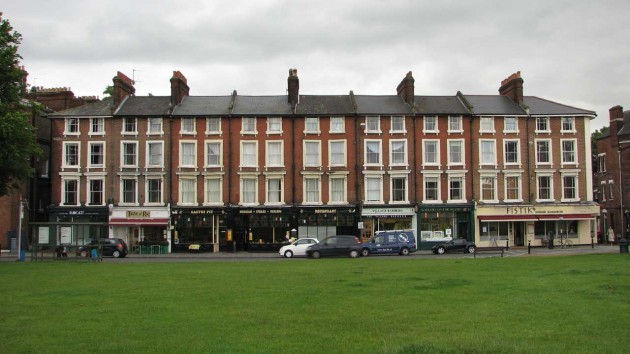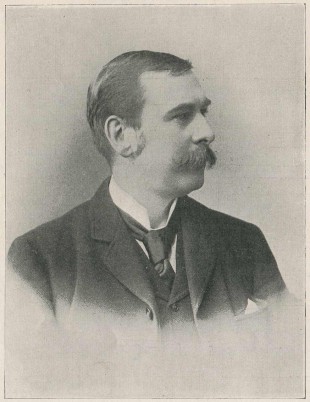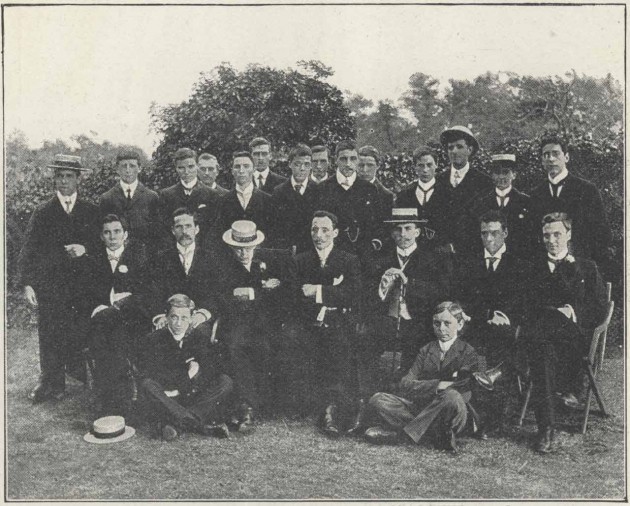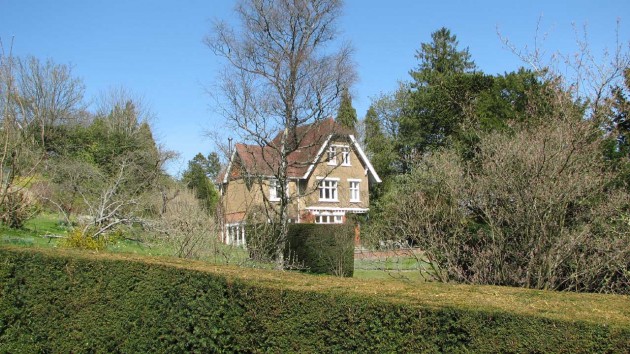…where east meets west
- Home
- Brief History
- The Greenwich Meridian
- Greenwich
(1675–1958) - Herstmonceux
(1948–1990) - Cambridge
(1990–1998) - Outstations (1822–1971)…
- – Chingford (1822–1924)
- – Deal
(1864–1927) - – Abinger
(1923–1957) - – Bristol & Bradford on Avon
(1939–1948) - – Bath
(1939–1949) - – Hartland
(1955–1967) - – Cape of Good Hope
(1959–1971)
- Administration…
- – Funding
- – Governance
- – Inventories
- – Pay
- – Regulations
- – Royal Warrants
- Contemporary Accounts
- People
- Publications
- Science
- Technology
- Telescopes
- Chronometers
- Clocks & Time
- Board of Longitude
- Libraries & Archives
- Visit
- Search
People: William Christie, Astronomer Royal
| Name | Christie, William Henry Mahoney | ||
| Place of work | Greenwich | ||
| Employment dates |
9 September 1870 – 1 Oct 1910 |
||
| Posts | 1870, Sep 9 |
Chief Assistant | |
| 1881, Aug 15 |
Astronomer Royal |
||
| Born | 1845, Oct 1 |
||
| Died | 1922, Jan 22 | Buried at sea (Latitude 40o 3.5' N, Long 9o 20' W, see below for map) | |
| Family connections | Father, Samuel Hunter Christie, was on the Board of Visitors from 1845–1864 |
||
| Known addresses | 1870–1881 | 12 Royal Parade, Blackheath |
|
| 1881–1839 | Flamsteed House, Royal Observatory Greenwich |
||
| 1910–1913? | Deepdale, Woldingham, Surrey |
||
| 1913–1922 | The Tower House, Downe, Kent (possibly occupied by late 1912?) |
||
| Wealth at death | £5002 17s 3d | Probate, 1922, May 27 (ODNB) |
|
| |
|||
Early life
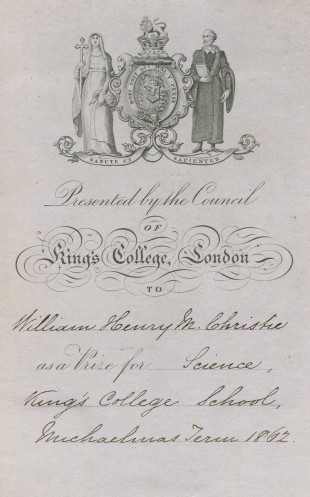
Bookplate from the Science Prize awarded to Christie in 1862. The book was Nichol's A Cylopaedia of the Physical Sciences (London & Glasgow, 1860)
William Christie was born in Woolwich on 1 October 1845. When his father retired in 1854 and went to Lausanne in Switzerland, he presumably took William and the rest of the family with him. By 1858 the family was living at 3 Ailsa Park Villas, Twickenham, Middlesex. William was educated at King’s College School, London (where he was awarded a prize for Hebrew and in 1862 a prize for science). He then went to Trinity College Cambridge where he matriculated in 1864, graduating in 1868 as fourth wrangler (the fourth best in his year) in the Mathematical Tripos. His abilities came to Airy’s attention in 1866 when he sat for the Sheepshanks Exhibition, for which Airy was an examiner. Although he failed the paper on lunar and planetary theory, he was the best candidate on the paper on practical astronomy, being described by Airy as ‘methodical, clear and accurate’. After graduating, Christie remained at Cambridge where he had a number of private pupils. He was elected a fellow of his college in 1869 and awarded his MA in 1871.
Chief Assistant
William Christie was just 24 years old when he was appointed to the post of Chief Assistant. He replaced Edward Stone who had moved on to become H.M. Astronomer at the Cape of Good Hope. In contrast to Christie, the existing assistants were not only older and well established, (the most junior, James Carpenter, having arrived at the Observatory some 15 years previously), they were paid on average half as much. Christie arrived for work on Friday 9 September 1870 (RGO6/26) and made his first recorded observation on 22 September.
The census returns for 1871 and 1881 tell us that during his time as Chief Assistant, Christie lived at 12 Royal Parade, Blackheath. The building appears to have been in multiple occupation with the lower floor(s) being occupied in 1871 by a Berlin Wool shop (in 2015, part of the CAU Restaurant). In 1871, Christie appears to have been lodging there with his sister Julia who was two years younger. In 1881 he was 35 years old and lodging with two of his other siblings both of whom were artists: Faraday (aged 29) and Mary (aged 27). Christie’s home-life during those ten years must have been very different to that of the rest of the staff at the Observatory.
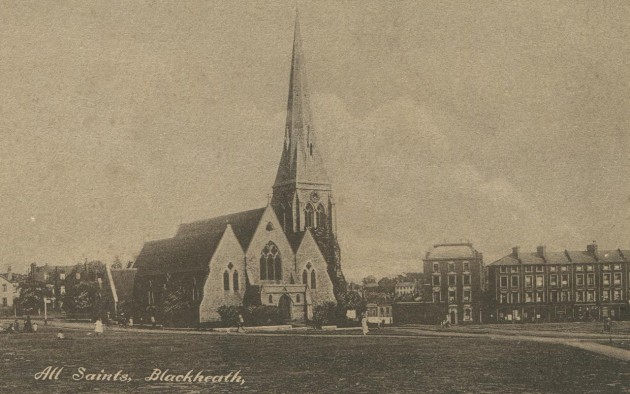
All Saints, Blackheath and part of Royal Parade in about 1910. Christie's house can just be seen on the extreme right. From a postcard published by C. & E. Ingram
Rejected for the Radcliffe and the Cape
Christie was one of four unsuccessful candidates for the post of Radcliffe Observer at Oxford in 1878 when the post went to Stone on the retirement of Robert Main. He was then unsuccessful in his bid to replace Stone as H.M. Astronomer at the Cape. That post was awarded to David Gill.
Appointment as Astronomer Royal
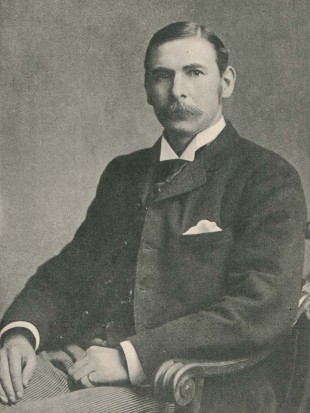
William Christie. This photograph, which is by Elliott & Fry, is one of the best known of Christie. It was used by Maunder in his articles about the Observatory published in the The Leisure Hour in 1898 and then in his follow up book Greenwich Observatory which was published in 1900
Family
At the time of his appointment as Astronomer Royal in 1881, Christie was still unmarried. Four months later, on Tuesday 13 December, at the age of 36, he married Violette Mary Hickman (b.1856) at Sedgley near Wolverhampton. Violette (who appears to have been christened Mary Violette) was the third daughter of Alfred Hickman, a wealthy industrialist from Wolverhampton, who became a member of Parliament in 1885. He had a house in one of London's most exclusive streets (22 Kensington Palace Gardens), as well as a country house, Tinegar (or Tinacre) Hall at Wightwick near Wolverhampton (now Wightwick Hall School). He was knighted in 1891, made a baronet in 1903 and died on 11 March 1910 leaving an estate of £1,000,000.
With Violette, Christie had two sons, Harold Alfred Hunter Christie (1884–1960) and Edward Hunter Christie, (1888–1891). Violette died in December 1888 a few weeks after giving birth and Edward a few years later. Christie never remarried. Violette is commemorated by a horse trough located outside The Old Stags Head, Church Hill, Wolverhampton, WV4 5JB (close to the church where she was married). It carries the inscription:
IN MEMORY OF VIOLETTE MARY
WIFE OF
W H M CHRISTIE ASTRONOMER ROYAL
DAUGHTER OF
ALFRED AND LUCY HICKMAN
Born on 1 October 1884, Harold started at Marlborough College in September 1898, winning a scholarship to Trinity Hall, Cambridge. As a young man, he took an interest in astronomy, accompanying his father on eclipse expeditions and patenting an improvement for erecting eyepieces in 1910. His spent his working life however as a lawyer. He died in 1960 and is buried at St Margaret’s Church, West Hoathly.
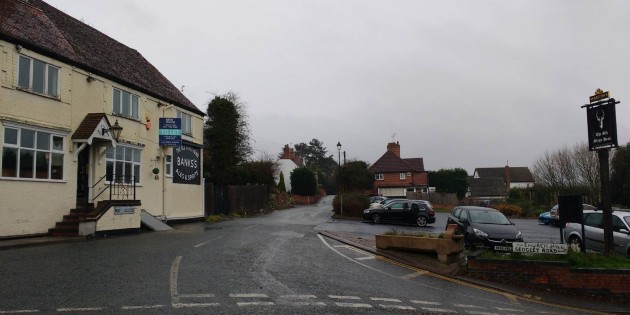
The horse horse trough outside the Old Stags Head, commemorating Christie's wife. Photo November 2018
According to Colin Ronan who had access to some of the family papers and who wrote Their Majesties’ Astronomers (London, 1967), Christie had his own private yacht, was well connected at Court and was a personal friend of Edward VII. Looking at the Journal which Christie kept spasmodically as Astronomer Royal (RGO7/30), it seems likely that the yacht was kept at Sandwich. In 1894, Christie notes going to Sandwich and neighbouring Deal for a long weekend on eleven separate occasions. It is not known where Harold was brought up prior to attending Marlborough College, but given his father’s long weekends away and business trips abroad, there has to be a suspicion that both he and his brother Edward were brought up by one of Violette’s relatives – a suspicion reinforced by the fact that Edward died in the District of Wolverhampton.
Societies and awards
Christie became a fellow of the Royal Astronomical Society in 1871. The following year he was elected onto its Council, on which he served for the next 40 years apart from the years 1879-80 when he stood down at his own request. In 1877 he founded The Observatory magazine, which is still in production today. He was the Society’s president from 1888-90.
Christie became a fellow of the Royal Society in 1881 and also served on its Council. He was awarded an honorary DSc from Oxford (1902) and was a Corresponding Member of the Academy of Sciences of Paris, the Imperial Academy of Sciences in Petrograd and of the Italian Spectroscopic Society.
Christie became a CB (Companion of the Bath) in 1897 on the occasion of the Queen’s diamond jubilee and a KCB (Knight Commander of the Bath) on 9 November 1904.
The boundaries of acceptable research
Airy was the longest serving of the Observatory’s leaders. Sometimes regarded as autocratic and arrogant, he took a clear view about the Observatory’s remit, particularly in light of its routine responsibilities and the limited funding available from the public purse. The wider issue of public funding of science in Britain came to a head in the late 1860s as the new subject of astrophysics was starting to open up. At the heart of the debate, was whether the government should sponsor a series of national astrophysical observatories or whether such work should be left to the combined efforts of Greenwich and the contributions of enthusiastic and often wealthy individuals (as it had been in the past). Against this background, in 1870, the government set up a Royal Commission on Scientific Instruction and the Advancement of Science. Chaired by William Cavendish the Seventh Duke of Devonshire and often referred to as the Devonshire Commission, its findings were published in a number of reports between 1872 and 1875. Click here to read Airy’s evidence to the commission which was given in 1872.
While all this was going on, business was very much as usual back at Greenwich and new programmes of work were initiated that included the measurement of the heat radiating from stars (1869–70) together with spectroscopy and daily photography of the Sun under the auspices of a newly established Solar Department (1873).
The problem of the Observatory’s reach was one that clearly vexed Airy. By 1875, the Observatory had been in existence for 200 years and Airy in office for 40. He took the opportunity to publicly review both the achievements of the past together with the work that the Observatory might be involved in the future. He believed most strongly that the Observatory should not involve itself with the ‘new physical investigations’, and added that if in the future the Observatory programme should be cut, it should be in the areas of Meteorology, Photoheliography and Spectroscopy; ‘not as unimportant in themselves, nor as ill fitting to the work of the Observatory, but as the least connected to its original aims’. The views and approach of Christie turned our to be altogether rather different.
Telescopes and buildings
During the nineteenth century, as London grew and became more industrialised, the observing conditions at Greenwich deteriorated. Today, St Paul’s Cathedral (which is a little less than five miles distant from the Observatory) can be seen on most days of the year. At the start of 1874, viewing conditions at Greenwich were so bad, that the Cathedral couldn’t be seen for months on end, eventually becoming ‘fairly visible for the first time’ that year on 17 May! Despite this, Airy was to finish his 1875 report to the Board of Visitors with the following paragraph:
‘The National Observatory will, I trust, always remain on the site where it was first planted, and which acquired the name of "Flamsteed Hill." There are some inconveniences in the position, arising principally from the limited extent of the hill, but they are, in my opinion, very far outbalanced by its advantages.’
Whilst Airy had been scrupulous in his requests for capital funding, each request for a new telescope being properly costed and preceded by a well-argued case; under Christie things were rather less transparent. During his period in office there was a massive increase in the number of large telescopes deployed. These were funded in part by the taxpayer and in part from generous donations.
Soon after becoming Astronomer Royal, Christie was offered as a gift, the 2-foot Reflector that had belonged to the recently deceased William Lassell. In his report to the Board of Visitors in the summer of 1883, Christie told them that: ‘The exceptional qualities of this fine telescope (with which Hyperion was discovered in 1848) are well known, and there could be no hesitation in accepting on the part of the Admiralty the offer of such a valuable gift.’
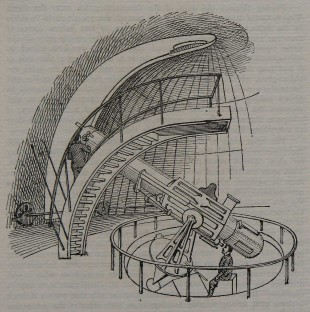
The Lassell Telescope in its dome at Greenwich. Sketched from life by an artist from the Pall Mall Gazette on 27 January 1888 (RGO7/29). The lower of the two observers is looking though the eyepiece of the Corbett 6½-inch refractor which was attached in January 1887 as both a guiding telescope and for the observation of occasional phenomena. Originally published by the Pall Mall Gazette on 30 January 1888, the drawing was reproduced by Cudworth on p.321 of his book: Life and Correspondence of Abraham Sharp (London, 1889)
One of Christie’s aims was to develop further the programme of determinations of proper motions of the stars with the aid of a spectroscope, which had been commenced in 1875 with the 12.8-inch Merz refractor. The Merz had proved too small to allow anything but the brightest stars to be observed and the newly acquired Lassell Telescope although more powerful, was unsuitable as its mounting and clock-work were not capable of carrying a heavy spectroscope. Christie therefore set about trying to procure a larger refractor. He was also motivated by the fact that at that time, there were 30 national or private Observatories with refractors larger than those at Greenwich. In 1885, he secured agreement from the Admiralty to provide the funding to allow him to replace the Merz with a larger 28-inch Refractor on the same mounting. The proposed new telescope was about 3m longer than the old. If Christie is to be believed, it was his intention to house it under the same drum dome that had covered the Merz. As works progressed it became apparent that because of structural damage the dome would have to be replaced. Christie came up with a rather elegant proposal for an onion shaped dome. With a diameter at its widest point of 36 feet, the dome was 5 feet wider than the tower on which it stood. It was completed in April 1893, though originally without the crown which was added in 1907/8. The telescope itself became operational at the start of 1894. It was of unusual design in that it was capable of being used both as a visual refractor and a photographic one, the switch from one mode to the other being brought about by the reversal of the crown-glass component of the object glass – something that was easier said than done. After trialling the telescope for six months, a regular programme of double star observations commenced together with a limited programme of spectrographic work. The later was abandoned in November 1895. For reasons that will be explained shortly, the telescope was never used in photographic mode after 1896.
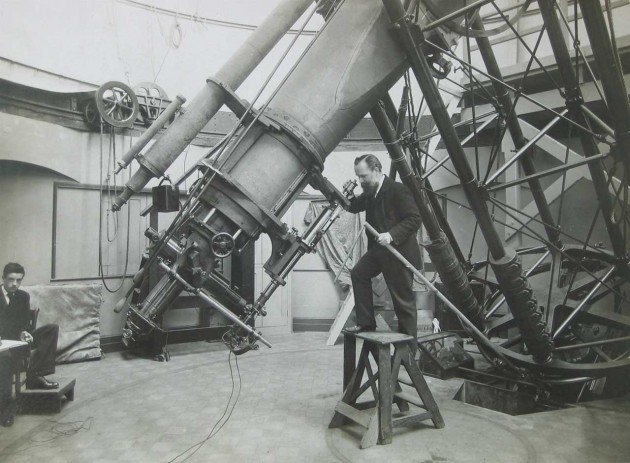
The 28-inch refractor with E Walter Maunder at the half-prism spectroscope. His assistant is William Bower, a computer, who became established in 1896. Photograph by David Edney, c.1895. Reproduced by permission of the Greenwich Heritage Centre (see below)
Meanwhile, back in 1887/8 Christie had secured Admiralty agreement to enable him to raise the west end of the Meridian Building by two stories at its western end to provide additional office space and allow for the construction of an 18-foot dome in which he said he intended to house one of the Observatory’s six-inch equatorials. A six-inch equatorial was never in fact installed, as not long afterwards, the Observatory became a participant in an international project to produce a photographic map of the sky (the Carte du Ciel), the new dome being used for this purpose instead. The Astrographic Telescope, which was ordered in August 1888, was installed there in 1890.
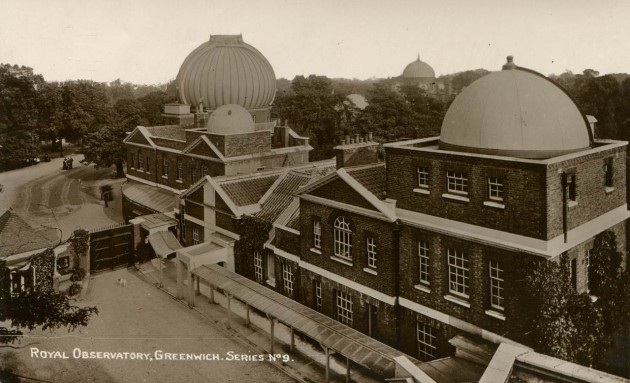
Taken in about 1909, this photograph shows the Astrographic Dome (right) and the onion dome of the Great Equatorial Building housing the 28-inch refractor (left). Postcard published by Henry Richardson, Greenwich
In 1889, Christie told the Board of Visitors that:
‘Owing to want of Space in the Observatory buildings the moveable instruments, clocks and other apparatus which are not in actual use, are for the most part stowed away in their boxes in wooden sheds, where their periodical examination and renovation are attended with great difficulty. For the proper care of these instruments it would be advisable that they should be housed in a brick building to serve as an Observatory museum for instruments and apparatus of scientific value or historical interest. A building of one story, about 40 feet long and 30 feet broad, would be suitable … the proposed building being connected with the circular Lassell building.’
A plan then evolved to build a two story building with two wings with the Lassell Dome rebuilt in the centre. A building with three wings was then toyed with. Finally it was agreed that a building with four wings surrounding a central tower with the Lassell Dome on the top should be built. Constructed in stages between 1891 and 1899, it became known as the New Physical Building (and more recently as the South Building or Astronomy Centre). During construction, plans changed for what was to be installed in the dome. By November 1891 it had been decided to replace the Lassell 2-foot Reflector with the 12.8-inch Merz on the same mounting. With the offer of funding for a new telescope from Sir Henry Thompson in 1894, plans to re-mount the Lassell Equatorial in the relocated dome were abandoned and the telescope (which had never lived up to expectation) effectively scrapped. Thompson’s offer having been accepted on behalf of the Admiralty, a new 26-inch Photographic Refractor was ordered from Grubb to mount there in its place. The following year, Thompson also offered to pay for the 30-inch Reflector which Christie had made plans to acquire. As there was to be no additional funding for a new building, the 26-inch refractor and the 30-inch reflector were planned to be mounted together on the same mounting. This was fine except for the fact that only one could be used at a time. Efficient use of both was therefore out of the question. The two new telescopes were brought into use at the end of 1898. With two dedicated photographic telescopes at his disposal as well as the 13-inch Astrographic, the 28-inch refractor was consigned to visual use only.
Meanwhile, once construction of the New Physical Building had got underway, Christie persuaded the Admiralty to replace Airy's Altazimuth Telescope with a new instrument to his own design to be housed in a new building immediately to the north of the Magnetic Observatory. Known as the Altazimuth Pavilion, it was built between 1894 and 1896. The new telescope was never a great success and was seemingly last used in 1929.
Both the Altazimuth Pavilion and the New Physical Building contained considerable amounts of iron, whose effect on the Magnetic Instruments could not be mitigated. As a result, the Admiralty had to foot the bill for moving the magnetic observatory to a new location within Greenwich Park, the piece of land that was fenced off becoming known as The Christie Enclosure.
Apart from upgrading the covered walkway from the Park, Christie made no significant alterations to Flamsteed House during his time as Astronomer Royal.
Large telescopes acquired by Christie
Lassell 2-foot Reflector (1845)
13-inch Astrographic Refractor (1890)
Thompson 9-inch Photographic Refractor (c.1888)
28-inch Refractor (1893)
Thompson 26-inch Photographic Refractor (1896)
Thompson 30-inch Photographic Reflector (1896)
Christie's Altazimuth (1896)
Instruments designed by Christie
Direct-vision ‘half-prism’ spectroscope (1877)
New buildings still surviving
The South Building and Lower Store (1891–9 & 1908)
The Altazimuth Pavilion (1894–6)
New buildings now demolished
The Lassell Dome (1883)
The Porter’s Lodge/Gate House (1890)
The Transit Pavilion (1891)
The Magnetic Pavilion (1898)
Buildings that underwent significant alteration
The Meridian Building (Meridian Observatory) (1887–8)
The Great Equatorial Building (28-inch telescope dome) (1893, 1898, 1908)
By the time that Christie was appointed as Astronomer Royal, despite what Airy had told the Visitors in 1875, it should have been obvious that Greenwich was not the place to be erecting new large telescopes. It was cramped and the skies were polluted … and the pollution was getting worse. And it wasn’t just the astronomical observations that were compromised while Christie was in office; the electrification of London’s railways that began in the 1890s caused magnetic disturbances that affected the magnetic instruments as well.
As outlined above, the manner in which the Observatory evolved under Christie was largely shaped by the unsolicited gifts of the Lassell and the two Thompson Equatorials. The purpose of many of the large telescopes that Christie acquired was ill defined and their design and installation subject to compromise. The two Thompsons, the Astrographic and the 28-inch refractor all ended up in domes originally designed for smaller instruments – a less than ideal situation in terms of providing the best possible observing environment. With no strategic plan for the Observatory’s development and with forever moving goalposts, not only were additional costs incurred, but there was a reduction in the overall usefulness of the telescopes and the Observatory’s potential productivity.
Looking at the way the Observatory grew under Christie, one might conclude that part of his approach was expansion by stealth. Had he had a proper strategic plan, it is possible that at least part of the Observatory would have been located away from the smoke of Greenwich by the start of the twentieth century.
Even the unfortunate erection of the Greenwich Power Station on the line of the Meridian which commenced in 1902, and the furore that later followed, failed to motivate Christie and the Board of Visitors to consider a move. Quite the opposite in fact; for when in 1908, Philibert Melotte (one of the Established Computers), discovered the eighth satellite of Jupiter, Christie claimed that this was testimony ‘to the suitability of the Greenwich climate for the observation of very difficult objects such as faint satellites and close double stars.’ One can only conclude that consciously or otherwise, Christie was more wedded to the convenience of his London location than he was to the need for securing improved observing conditions and efficient use of his instruments.
But the smoke pollution was not the only problem with the Greenwich site. By the time Christie retired, it was well established that a site like Greenwich, perched on the edge of a plateau, was less than ideal for making zenith observations due to the increased likelihood of refraction anomalies. What was required instead was a site where the terrain to the north and south was both level and open – a condition that could not be satisfied at Greenwich.
History has been kind to Christie and he is often lauded for the expansion that took place under his command. But in truth, it was arguably the expansion at Greenwich that sowed the seeds for the Observatory’s ultimate demise. The best observing sites in the UK were always going to be inferior to those the best that had begun to be secured overseas. If Christie had had the foresight to orchestrate a move in whole or in part, the many difficulties that arose in later years, (particularly those relating to the Second World War and the move to Herstmonceux), might have been avoided and astronomy in the UK might well have evolved along different lines with the Greenwich Observatory still having an operational role today.
The Observatory under threat
In 1902, work was started by the London County Council (LCC) on the construction of Greenwich Power Station. Built on the banks of the River Thames at a distance of just half a mile from the Observatory and exactly on the line of the Greenwich Meridian its location was detrimental to the operation of the Observatory. What seems rather curious is that no one appears to have commented on the location or raised any objections until 1905 when phase one was nearing completion. In 1906, Christie raised his concerns with the Board of Visitors at the visitation which took place on 30 May. By this time, phase one was up and running. As was the norm, details of the visitation were reported in the press. In the ensuing weeks, numerous follow-up articles about the impact of the power station on the Observatory were published, including one titled Menace on the Meridian that appeared in the 23 June edition of The Graphic. An official enquiry ensued in which a number of recommendations were made in order to mitigate the impact of the power station on the Observatory. These included lowering the two chimneys of the yet to be completed phase two as well as taking steps to reduce vibrations. In all the ensuing hullaballoo, the finger of blame when pointed, was directed towards the LCC. No one seems to have asked why Christie, the Admiralty and the Board of Visitors were so slow in raising their objections.
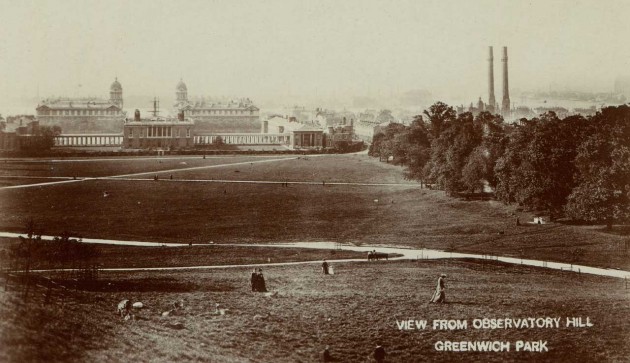
When this photo was taken, just the two chimneys of phase one of the power station had been completed (right). From a postcard published anonymously
The staff regradings of the 1870s
At the start of the 1870s, Airy was actively seeking to establish a new (and improved) pay scale for the assistants. This resulted in the introduction of the new grades of first class assistant and second class assistant in 1871. The restructuring coincided with the introduction of open competitive examinations administered by the Civil Service Commissioners and these were used to fill vacant posts at the lower grade. Entry to the examination was restricted to people of age 18 to 25. Therefore if a computer hadn’t obtained promotion by the age of 26, he would have no prospect of ever being taken on as a permanent member of staff at the Observatory. With vacancies at the Junior Assistant grade being rare and normally only arising when an assistant retired, some computers would have had virtually no chance of ever gaining promotion, no matter how good they were.
Staff changes introduced by Christie in the 1880s and 1890s
By 1888, Christie had been Astronomer Royal for seven years and overseen a considerable expansion in the number of telescopes both deployed and planned. But the number of staff both permanent and temporary had remained essentially unchanged. Unable to secure funding for additional assistants, Christie did manage to secure an increase in the budget for temporary computers.
Extra computers were all very well, but what Christie really wanted was more assistants. To this end, he therefore made the decision to experiment with employing ‘Lady Computers’. Only women who had graduated at a University Ladies’ College were considered. Four such assistants were taken on in 1890: a Miss Clemes, together with Miss Rix and Miss Furniss from Newnham College Cambridge and Miss Everett from Girton College Cambridge. All four began work on 14 April (RGO7/29). Clemes appears to have left very quickly and Furniss who resigned in 1891 was replaced by Annie Russell (RGO7/29), a contemporary of Everett’s at Girton. Although older and considerably better educated than the Boy Computers, their pay and conditions were the same. But unlike the boys who were generally still living with their parents, the Lady computers had to find (and presumably pay for) their own accommodation. Rix resigned in 1892 on health grounds, Everett secured a position at the Observatory in Potsdam in 1895. Russell resigned a few weeks later on 31 October and married her colleague E Walter Maunder at the end of the year.
Many modern commentators speak of Christie’s social innovation. But in truth, the employment of the Lady Computers was exploitative and little more than a stop-gap measure. By the time Russell resigned, the problem of insufficient numbers of established staff was about to be resolved and no more ladies were appointed. Indeed, those making enquiries were told ‘ladies are no longer employed at the Royal Observatory’. The next time women were employed at the Observatory was again as Computers and again out of necessity. But this time it was because of the staffing shortages caused by the First World War. Click here to read an extensive article about Christie’s ‘Lady Computers’.
In 1891, Christie was authorised to employ two additional assistants. But he remained unsatisfied. The increasing reliance on the Temporary Computers to do work that in the past would have been done by assistants was stating to compromise the continuity of the Greenwich series of observations. By the time they had gained enough experience to become really useful, they hit the age bar and would leave. The problem in his view, was exacerbated by the fact that since 1873, all new second class assistants had been appointed by the civil service commissioners through open competition – a system that failed to ensure that candidates were qualified as observers.
Eventually in late 1896, after two years of waiting on a decision from the government, a reform of sorts took place. Christie was granted a second Chief Assistant and the grade of Second Class Assistant (of which three of the five posts were vacant) was replaced by the two grades of established computer (6 posts) and higher grade established computer (2 posts). This increased his established staff from 11 to 15. The higher grade posts were filled by the existing second class assistants. The vacancies were then filled by competitive examination from the Temporary Computers – a process that continued until 1936 when the post of temporary computer was abolished following the removal or the Royal Hospital School from Greenwich to Holbrook.
In 1912, the posts of Higher Grade Established Computer and Established Computer were renamed Junior Assistant Higher Grade and Junior Assistant.
One consequence of Christie’s methods of recruitment was that between 1923 and 1937 all the Heads of Department were ex-computers. This was in complete contrast to the period 1904 to 1917, when all the Heads of Department had had no experience of being a Computer, having been originally appointed directly to the post of Second Class Assistant (mainly as graduates) after competing in the Civil Service exams between 1872 and 1896. It was also in complete contrast to the First/Chief Assistants, who from 1835 until the 1950s (with the exception of Dunkin) were exceptional maths graduates and tended to be recruited into post more or less straight from university. All except Atkinson (who graduated from Oxford), were wranglers i.e. had first class degrees in mathematics from Cambridge. Main was sixth wrangler (sixth in his class), Stone was fifth wrangler, Christie was fourth wrangler, Turner and Dyson were both second wranglers and their successors Cowell and Eddington both senior wranglers (top of their class). In 1910, rankings ceased to be made public, so the rankings of the remainder are unknown. This manner of selecting Chief Assistants was criticised by David Gill the Astronomer Royal at the Cape of Good Hope (1879–1907), who in 1897 wrote: ‘They enter into chief positions where they have to superintend men who know much more about practical work than they do, and they have to pick up what they can of a hard and fast hide-bound system – which they are taught to regard as unquestionably superior to all others’.
In 1901, a third of all the temporary computers left in a period of just five months putting great stress on the Observatory’s regimes. By contrast, amongst the established staff, the only member to leave between 1896 and 1908 was Dyson, who resigned to take up the post of Astronomer Royal for Scotland.
Dyson came back to Greenwich as Astronomer Royal in 1910. When he left office in 1933, as well as his two chief assistants, he had nine other senior members of staff. Of these, eight (Bowyer, Cullen, Davidson, Edney, Furner, Melotte, Stevens and Witchell) were already established members of staff when he arrived as Astronomer Royal in 1910. And of those eight, four (Bowyer, Davidson, Edney and Furner) were already working at the Observatory as Boy Computers when he first arrived as Chief Assistant in 1894, with two, (Melotte and Witchell) being taken on soon after.
Stress and ilness
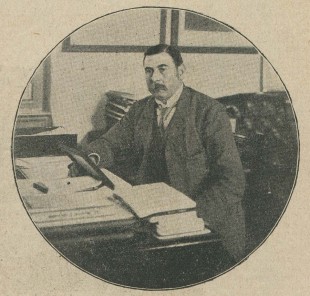
An older and less sprightly looking Christie in his office in the New Physical Building. From The New Penny Magazine (1902)
In June 1905, Christie was ordered by his Doctor to give up his work immediately, leave Greenwich and live in the open air, giving up his duties and responsibilities altogether (ADM190/16). The physician’s report sent to the Board’s Chairman, Sir William Huggins, stated amongst other things that his capacity for work was small and for sustained work was nil.
Christie’s symptoms suggest he was suffering from a combination of stress and heart failure. They were listed in the report as follows:
- His pulse is rapid and feeble – the heart being irritable and tending to dilate
- The blood vessels throughout the body are slightly infected and the liver is a little swollen
- The nervous system is feeble and excitable and there is a marked tendency to insomnia.
As a result, he missed the annual meeting of the Board of Visitors. According to Dyson, the illness was a repeat of one that he had had a few years earlier. Reading between the lines, it seems likely that Christie was afflicted throughout his last ten years as Astronomer Royal. Records are scanty, but we do know that the 1910 visitation was postponed by two weeks because of his illness (RGO190/7). We also know from what Turner wrote in his obituary (see below), that Christie lacked energy in his later years. This would have affected his ability to lead effectively and was almost certainly something of which the Visitors were aware, even though it is never formally alluded to in their records.
Popular writings
Airy was the first of the Astronomers Royal at Greenwich to write for a wider public. Spencer Jones was the most readable and prolific. Christie however lacked the popular touch. His only book, Astronomy, was published in 1875 while he was still Chief Assistant. Republished in America in 1882 and England in 1889 and 1892, it was not a compelling read. It opened with the following somewhat off-putting sentence:
‘Although this little Manual is quite elementary in its character, my main aim has been to make it precise rather than popular in its language, and I have therefore entered on certain points which will probably present some difficulty to the beginner.’
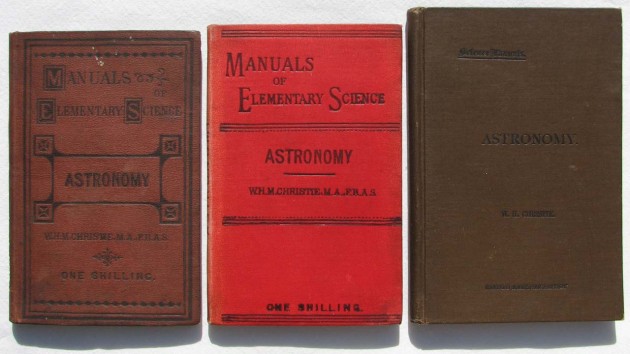
Three of the four editions of Christie's Astronomy. Left, the edition of 1875. Centre, the edition of 1892. Right, the American edition of 1882
All editions of Christie’s book are hard to find, suggesting that it did not sell in large numbers. Wisely, Christie seems to have stepped back and left the popularising of astronomy to his very capable assistant E Walter Maunder, whose books sold in large numbers. Click here to read the 1875 edition.
Retirement to Woldingham
When Christie retired in October 1910, he became the first Astronomer Royal to retire at the age of 65. When he left the Observatory he moved with his son Harold to a relatively isolated, eight bedroom, late Victorian house called Deepdale in Woldingham, Surrey.
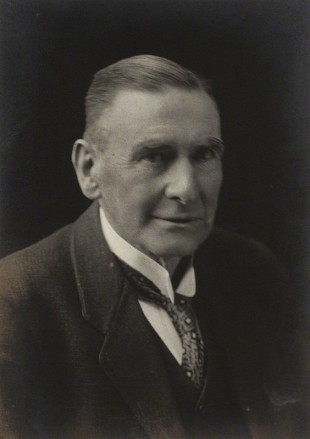
A late portrait of William Christie. Bromide print by Walter Stoneman, 1920. © National Portrait Gallery, London. Reproduced under a Creative Commons Attribution-NonCommercial-NoDerivs 3.0 Unported (CC BY-NC-ND 3.0) licence (see below)
By 1914, the Christies had moved again, this time to Downe in Kent. Also in 1914, Christie was one of two new visitors appointed to the Board of Visitors on the death of Robert Ball and David Gill. As was the custom, he remained on the Board until his own death in 1922. Click here for a list of all the visitors from 1831–1964.
The house in Downe
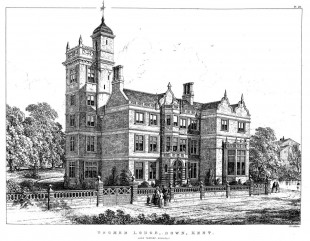
Tromer Lodge as it would have looked if all the scheduled building work had taken place. The planned additions were: the tower, the porch with the bow-window above it and the wing on the right. Plate 29 from Volume 17 of The civil engineer and architect's journal (1854)
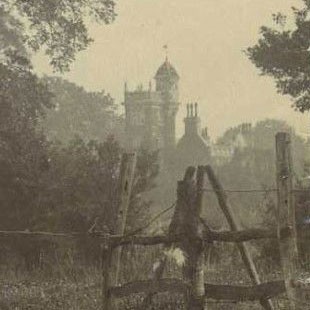
A distant view of the Tower House from the north c.1905. Note the absence of the pitched roof. Detail from a postcard published by Daniell Brothers Ltd., Lewisham
Built in the 1700s, the house has been known by a variety of names, including: Pond House, Tro(w)mers and Tro(w)mer Lodge. Although a tower was added in 1854 for the then owner the Rev. Robert Ainslie the house is not thought to have been known as the Tower House until much later.
Ainslie was a controversial character who Darwin described in his letters as litigious (1845), as a beast (1858) and as a rogue (1860). In 1854, Ainslie was involved in two libel cases involving the London Missionary Society. In the first case he was the plaintiff, in the second, the defendant. He won the first, but lost the second. The second case was heard in the autumn while the building work associated with the tower and other alterations to his house was in progress. After seven days of hearings and with only one third of the evidence heard and costs mounting, Ainslie changed tack and offered to make a full and ample apology which was accepted (click here to read more about the second libel case and click here to read more about the first). Although the damages awarded against him were nominal, Ainslie became liable for all the costs. These were estimated to be 3,000 sovereigns by The Christian Journal (which described Ainslie as a man with ‘a herculean body and a fiery spirit’). This large and unexpected expense appears to have stopped him from seeing his building plans though to completion. An article describing the tower together with the other proposed additions and alterations (devised by the architect John Tarring), along with an engraving of how the building was supposed to look once completed, was published in Volume 17 of The civil engineer and architect’s journal in 1854 (click here to read and here for the illustration). A comparison of the published illustration with subsequent period photographs, shows that several key elements of Tarring’s design (including the large extension on the right and the pitched roof of the second floor) were never completed. As a result, what should have been an internal wall ended up being a rendered external one (as can be seen in the photograph below).
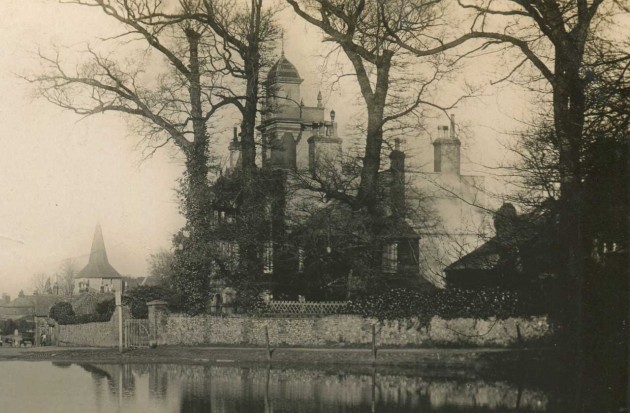
The Tower House, with St Mary's Church in the distance to its left. Detail from a postcard published by WJ Abbott and posted in 1918
Death at Sea
On 20 January 1922, Christie set out on a cruise to Morocco. On 22 January he suffered a gastric haemorrhage and died. He was buried at sea at off the coast of Portugal at the location shown below:
On Christie’s death, his son Harold, who had married Nora Agnes Brooks in 1921, remained at the Tower House where he brought up his three sons, the first of whom, Eric, was born on 18 August 1922. In the mid 1930s, the family moved to Chelsea (36 Sloane Court West?).
In 1937, the house was extensively remodelled and the tower and top floor removed. Still known as the Tower House in the 1960s, the name has since been changed to Trowmers (which was first seemingly used for a few years in the early 1900s when the house was occupied by Percy Russell).
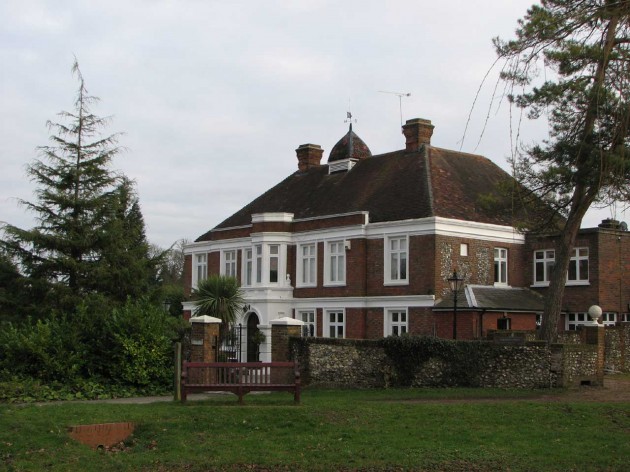
Trowmers in January 2009. The village pond in front of the house was badly damaged by two heavy anti-aircraft shells in around 1943 and now only holds water during very heavy rain or wet weather
Obituarys and further reading
Obituary, by Frank Dyson. Proceedings of the Royal Society A. (1923) (downloads as pdf)
Obituary, by HP Hollis. Monthly Notices of the Royal Astronomical Society, Vol. 83, pp.233–241, (1923)
Obituary, by former Chief Assistant HH Turner. The Observatory, Vol. 45, pp.77–81, (1922)
Christie, Sir William Henry Mahoney (1845–1922), A. J. Meadows, Oxford Dictionary of National Biography, Oxford University Press, 2004
Hickman, Sir Alfred, first baronet (1830–1910), Anne Pimlott Baker, Oxford Dictionary of National Biography, Oxford University Press, 2004
Image licensing information
Portrait of William Christie. Bromide print by Walter Stoneman, 1920. © National Portrait Gallery, London. Reproduced under a Creative Commons Attribution-NonCommercial-NoDerivs 3.0 Unported (CC BY-NC-ND 3.0) licence. National Portrait Gallery Object ID: NPG x67070.
Acknowledgements
Special thanks are due to the Greenwich Heritage Centre for permission to reproduce the photograph of E Walter Maunder with the half-prism spectroscope on the 28-inch refractor
© 2014 – 2026 Graham Dolan
Except where indicated, all text and images are the copyright of Graham Dolan
